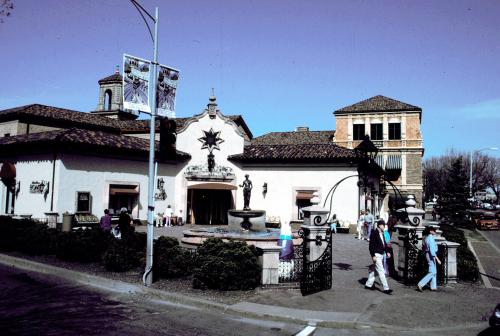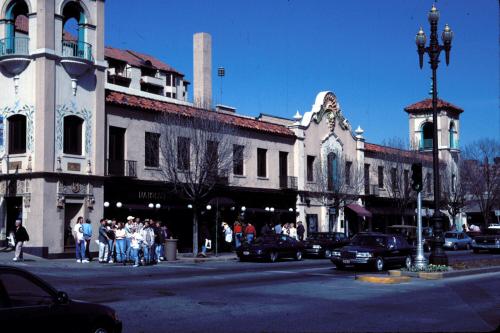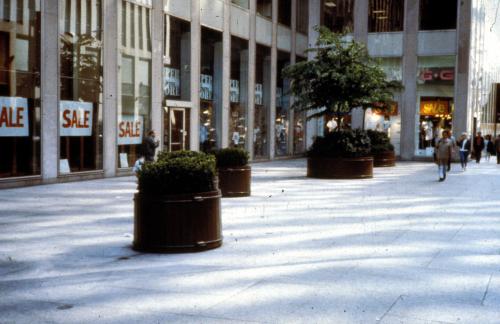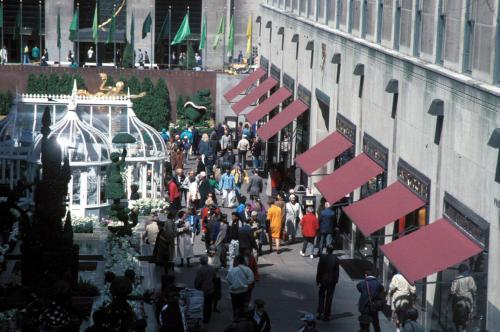People often ask me if a building has to be old or look historic to create a sense of place. I always answer with a definite "No!" While it may be easier to find older buildings where public activity flourishes, their success is not due to age or a particular architectural style. The main factor is actually how the base of the building is treated. A building with a well-designed (and well-managed!) ground floor can be a great place regardless of the style in which it is constructed. Let's look at two places which I think illustrate this point quite effectively: Country Club Plaza in Kansas City, and Rockefeller Center in New York.
People often ask me if a building has to be old or look historic to create a sense of place. I always answer with a definite "No!" While it may be easier to find older buildings where public activity flourishes, their success is not due to age or a particular architectural style. The main factor is actually how the base of the building is treated. A building with a well-designed (and well-managed!) ground floor can be a great place regardless of the style in which it is constructed. Let's look at two places which I think illustrate this point quite effectively: Country Club Plaza in Kansas City, and Rockefeller Center in New York.
Country Club Plaza, which debuted in the 1920s, is one of the nation's oldest shopping centers. Built in a style that mimics the architecture of Seville, Spain, it succeeds as a pedestrian district even though it was developed to accommodate cars. A few years ago PPS interviewed the managers of the complex, and we found that they attributed their success to four things. One, they offered a mix of attractions that appeal to a broad array of people – for example, by varying the price ranges of retail and restaurants. Second, they located necessities (e.g. bank branches, or doctors' and dentists' offices) in places that would lead people to pass by retail stores en route. Third, everything in the development allowed people to interact with it in some way. Children could touch sculptures; people could sit by pools and fountains; window displays were designed to maximize intrigue; outdoor cafes hosted jazz performers and other entertainment. And last, but certainly not least, blank walls were not allowed anywhere. Where management identified sterile areas around the exterior of the complex, they added plantings or artwork to liven the space up for passersby. What's remarkable is that, even though the Plaza is widely known for its historicist aesthetic, the people who run it cite very different reasons for its enduring popularity.

Country Club Plaza's courtyards provide places for interaction.

There are no blank walls at Country Club Plaza.
Rockefeller Center, though it was constructed just a short time after Country Club Plaza, couldn't look more different--but it is an even better public space. Its soaring forms are modernist icons, and the closer you get, the more these buildings come alive. Art deco sculptures grace the entrances. Ground floor windows protrude slightly from facades, enticing people to slow down and take a look at the goods inside. Changing exhibits and events in the center of the complex keep it humming in every season, while artfully placed wooden benches enable people to pause, rest, reflect, and take it all in. Here, a modern aesthetic gracefully accommodates a great public space.
Contrast the original Rockefeller Center with the more recently developed Rockefeller Center West (built in the 1970s on the west side of Sixth Avenue), however, and you'll see a very different way of building which has no sense of place. The buildings here do not have human-scaled bases: Store windows and entrances are set back from the sidewalk by nearly 50 feet, and the space between the building and the curb is basically empty. The retail is hidden so few people go window shopping. There is no reason for people to linger or make a return visit.

Newer part of Rockefeller Center.

Older part of Rockefeller Center
Rockefeller Center and Country Club Plaza make it clear that success as a public space is independent from architectural style. But as Rockefeller Center West illustrates, newer buildings often fall short of the mark. This is also true regardless of style. In fact, many of the worst new buildings are those designed to look old or historic, which don't work because they hide their ground floor uses behind a "charming" facade.
So although great new buildings may be few and far between, I stand behind my emphatic "No" -- there is NO reason new architecture can't contribute to an enhanced sense of place in the public realm. I would love to hear from readers of this blog about new buildings that succeed at their base--that engage the sidewalk with transparent ground floors and a mix of retail and other uses. What new architecture is striving to create better places?

Analysis: Cybertruck Fatality Rate Far Exceeds That of Ford Pinto
The Tesla Cybertruck was recalled seven times last year.

National Parks Layoffs Will Cause Communities to Lose Billions
Thousands of essential park workers were laid off this week, just before the busy spring break season.

Retro-silient?: America’s First “Eco-burb,” The Woodlands Turns 50
A master-planned community north of Houston offers lessons on green infrastructure and resilient design, but falls short of its founder’s lofty affordability and walkability goals.

Test News Post 1
This is a summary

Analysis: Cybertruck Fatality Rate Far Exceeds That of Ford Pinto
The Tesla Cybertruck was recalled seven times last year.

Test News Headline 46
Test for the image on the front page.
Urban Design for Planners 1: Software Tools
This six-course series explores essential urban design concepts using open source software and equips planners with the tools they need to participate fully in the urban design process.
Planning for Universal Design
Learn the tools for implementing Universal Design in planning regulations.
EMC Planning Group, Inc.
Planetizen
Planetizen
Mpact (formerly Rail~Volution)
Great Falls Development Authority, Inc.
HUDs Office of Policy Development and Research
NYU Wagner Graduate School of Public Service

























